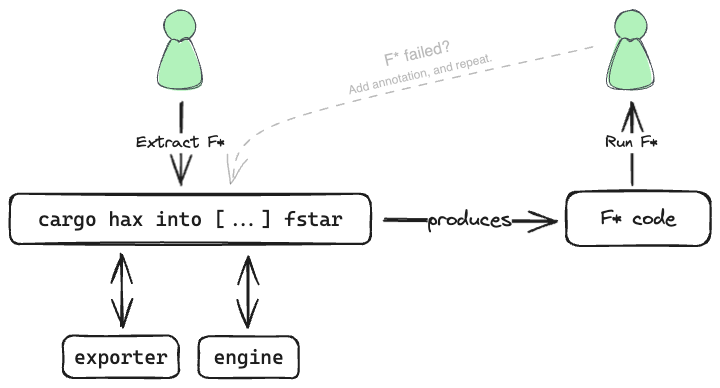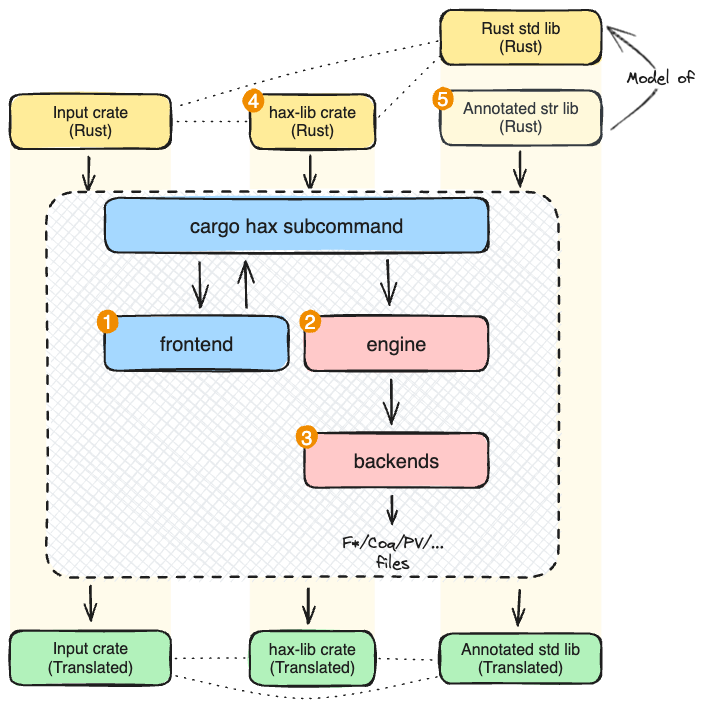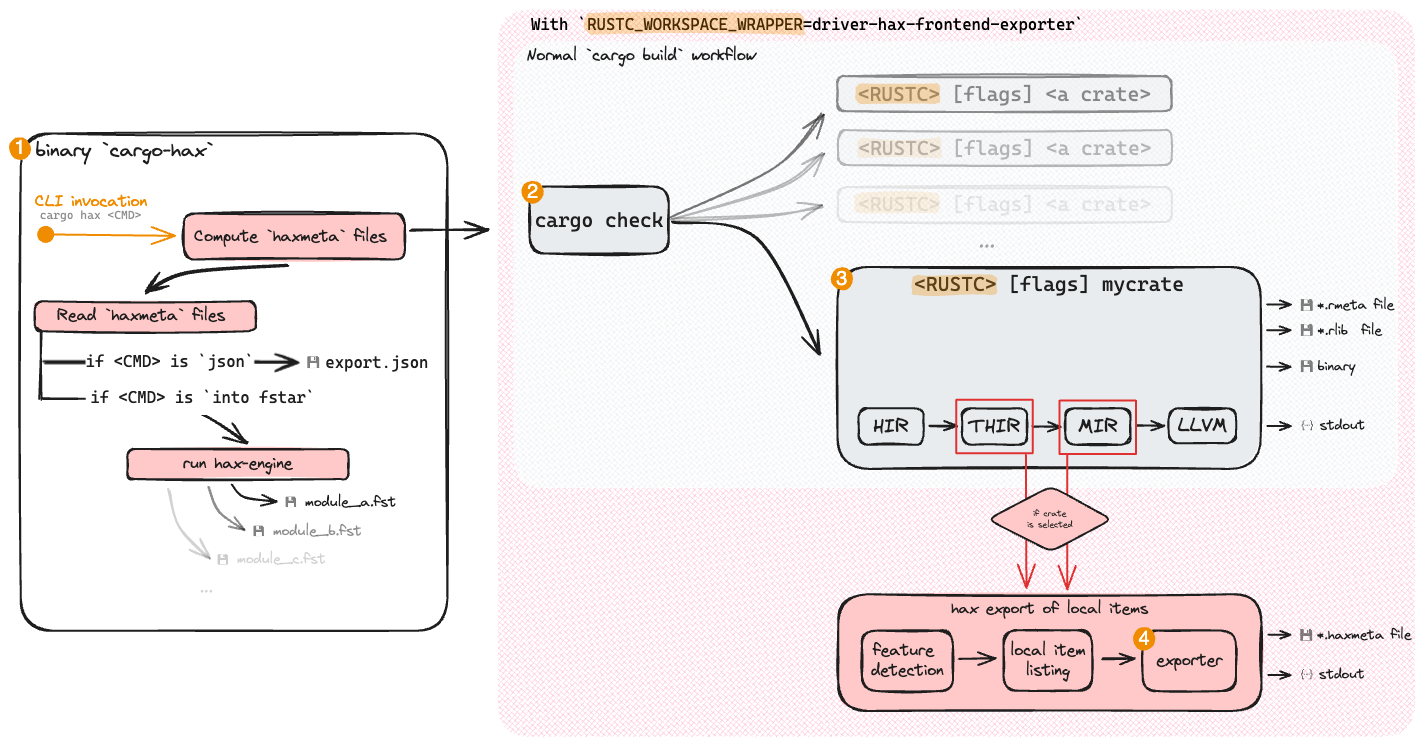Frontend
hax is a tool designed to facilitate the formal verification of Rust programs. It enables the translation of Rust crates into formal languages like F* or Coq. Once translated, these formal representations allow to write formal proofs about the behavior and correctness of their Rust code.
User flow
This document focuses on a specific user flow: extracting F* code. The process described here applies similarly to all other backends, including F*, Rocq, SSProve, ProVerif, and EasyCrypt.
The goal is for the user to prove a property on a Rust function, f, using the F* formal language. The function f is defined in the module mymod, within the crate mycrate.
To achieve this, the user follows these steps:
- Annotate the Rust crate mycrate with the properties to be proven and, if needed, provide proof hints.
- Run the command
cargo hax into -i '-** +mycrate::mymod::f' fstar. - Execute F*. If F* fails to prove the specified properties, the user revisits step (1) to refine the annotations and proof hints.
For a practical guide on using Hax, please refer to the manual.
High-Level Architecture of Hax
Hax consists of five main components, as illustrated in the diagram below, with each numbered step directly corresponding to its labeled section in the diagram:
- The frontend handles the extraction and export of given Rust crates into abstract syntax trees (ASTs).
- The engine performs a series of phases and rewrites, simplifying and transforming the Rust program as needed.
- The backends --one per target language-- request the engine to simplify the Rust program for their specific target and then pretty-print the program as F*, Roq, PV, or other formats.
- The Rust helper crate, hax-lib, provides Hax-specific helpers and macros to annotate a Rust program with properties, invariants, or proof hints.
- The annotated standard library is a work in progress partial model for the
Rust base libraries (
core,std,alloc), enriched with logical properties to assist in formal verification.
In the diagram, the dotted lines indicate dependencies between Rust or F* artifacts, flowing from left to right.
The user begins by exporting a crate (referred to as the "Input crate" in the
top left of the diagram). This crate depends on both the Rust std library and
hax-lib. The std dependency is added automatically by Rust, while the
hax-lib dependency is introduced by hax.
The input crate passes through the hax toolchain as follows:
- First, the crate is parsed and exported as JSON by the frontend (➊), with
assistance from the Rust compiler.
- Next, the engine processes the exported data (➋), transforming and
simplifying it.
- Finally, the F* backend generates the corresponding F* files (➌).
Since the input crate depends on both std and hax-lib, the generated F*
modules maintain these dependencies. To handle this, Hax translates hax-lib to
F* (➍) and also translates our model of the std library (➎) into F*.
Ast Extraction Workflow
This section delves into the technical details of hax's extraction process. The process involves the following components (as illustrated in the diagram below, with each numbered step directly corresponding to its labeled section in the diagram):
cargo-hax: a binary that provides a custom commandhaxtocargo.cargo check: thechecksubcommand ofcargo. It is sensitive to the environment variableRUSTC_WORKSPACE_WRAPPER: when set,cargowill call the program specified by$RUSTC_WORKSPACE_WRAPPERinstead ofrustc.driver-hax-frontend-exporter: a customrustcdriver. Instead of compiling Rust into a binary,driver-hax-frontend-exporterexports ASTs as JSON.hax-frontend-exporter: a library that mirrors Rust's internal ASTs as its own enriched AST representation. This library also provides bridges from Rust's ASTs to its enriched ASTs.
When cargo check compiles a crate, it invokes rustc multiple times, but only
some of these calls are relevant to us. Additionally, cargo check may also
build dependencies. As a result, we inject our custom export logic selectively,
ensuring that driver-hax-frontend-exporter behaves exactly like rustc in
all other cases.
During compilation, rustc produces several artifacts:
*.rmetafiles: metadata files containing type information, function signatures, constants, and more.*.rlibfiles: static library artifacts with compiled Rust code and metadata.- Diagnostic messages: messages on standard output for communication with
cargo check, including errors, warnings, and status updates.
Our custom export logic extends this by generating additional artifacts:
*.haxmetafiles: similar to Rust's*.rmetafiles, but contains full enriched abstract syntax trees. Thehaxmetafiles contains a binary serialization of theHaxMetatype.- Diagnostic messages: sent to standard output and used to communicate
specifically with
cargo hax. Those messages are JSON serializations of theHaxDriverMessagetype.
After calling cargo check, cargo hax parses the *.haxmeta files and
continues further along the hax toolchain, either by outputting JSON directly or
by calling the engine to generate files for targets such as F*, ProVerif, or
Roqc.
cargo-hax, driver-hax-frontend-exporter, and hax-frontend-exporter
together form what we refer to as "the frontend". The engine is represented by
the binary hax-engine, which includes the backends. The frontend is
implemented in Rust, while the engine is implemented in OCaml. Communication
between all components occurs through stdout, stderr, or stdin,
using JSON messages defined in the Rust crate
hax-types.
This section provides an overview of the workflow of the frontend of hax.


